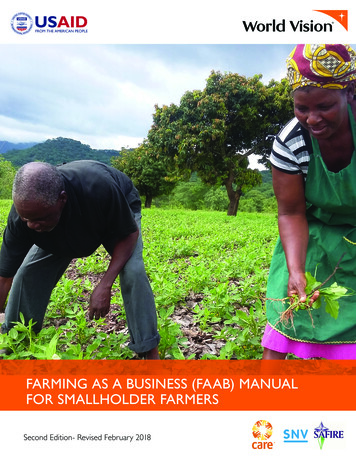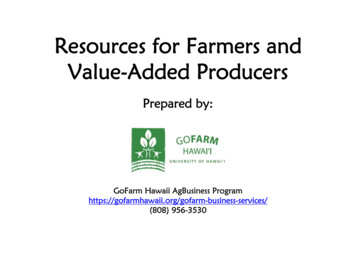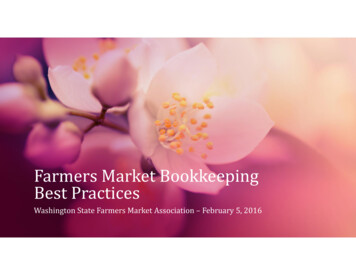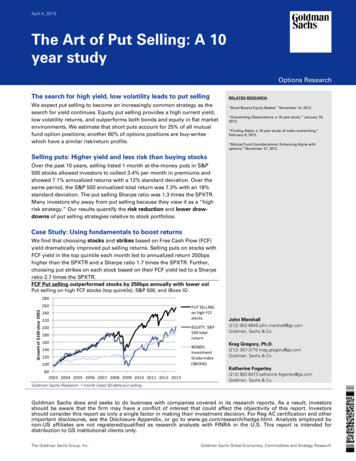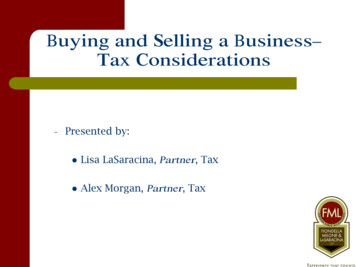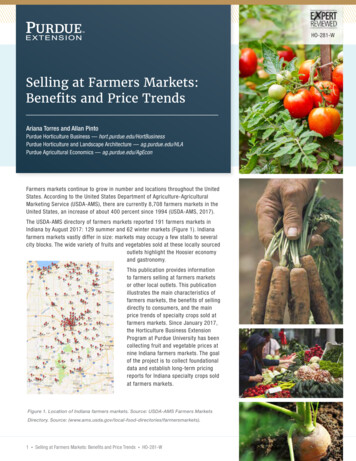
Transcription
HO-281-WSelling at Farmers Markets:Benefits and Price TrendsAriana Torres and Allan PintoPurdue Horticulture Business — hort.purdue.edu/HortBusinessPurdue Horticulture and Landscape Architecture — ag.purdue.edu/HLAPurdue Agricultural Economics — ag.purdue.edu/AgEconFarmers markets continue to grow in number and locations throughout the UnitedStates. According to the United States Department of Agriculture-AgriculturalMarketing Service (USDA-AMS), there are currently 8,708 farmers markets in theUnited States, an increase of about 400 percent since 1994 (USDA-AMS, 2017).The USDA-AMS directory of farmers markets reported 191 farmers markets inIndiana by August 2017: 129 summer and 62 winter markets (Figure 1). Indianafarmers markets vastly differ in size: markets may occupy a few stalls to severalcity blocks. The wide variety of fruits and vegetables sold at these locally sourcedoutlets highlight the Hoosier economyand gastronomy.This publication provides informationto farmers selling at farmers marketsor other local outlets. This publicationillustrates the main characteristics offarmers markets, the benefits of sellingdirectly to consumers, and the mainprice trends of specialty crops sold atfarmers markets. Since January 2017,the Horticulture Business ExtensionProgram at Purdue University has beencollecting fruit and vegetable prices atnine Indiana farmers markets. The goalof the project is to collect foundationaldata and establish long-term pricingreports for Indiana specialty crops soldat farmers markets.Figure 1. Location of Indiana farmers markets. Source: USDA-AMS Farmers MarketsDirectory. Source: rkets).1 Selling at Farmers Markets: Benefits and Price Trends HO-281-W
Indiana Growers Selling at Farmers MarketsThe latest Census of Agriculture reported that 244,974 U.S. farmers utilized more than 14million acres to grow specialty crops in 2012. The same census reported that Indiana’sspecialty crop industry includes 2,935 operations utilizing 63,252 acres to grow fruits andvegetables, tree nuts, dried fruits, horticulture, floriculture, and nursery crops. Thus, specialtycrops include a long list of agricultural products that are sold through a wide variety ofmarket channels.In a 2012 survey of specialty crops growers, Torres and Marshall (2016) and Torres (2017)found that 86 percent of interviewed farmers in Indiana reported annual revenues less than 250,000. Almost a third of Indiana farmers made less than 10,000 annually. Their surveyalso found that about a third of the farmers reported additional off-farm sources of incomewhile still spending an average of 46 hours per week on farm activities. The survey foundthat most specialty crops farmers who sell their fruits and vegetables through farmersmarkets or other local outlets, tend to be smaller, and grow 20 crops on average.More information about specialty crops operations in Indiana are available in Fruit andVegetable Farmer Surveys: Characteristics of Indiana Vegetable Farming Operations (PurdueExtension publication HO-270-W) and Fruit and Vegetable Farmer Surveys: Characteristicsof Indiana Vegetable Farmers (HO-271-W). Both are available from the Education Store,edustore.purdue.edu.Benefits of Selling at Farmers MarketsFarmers markets are much more than just a place to sell produce; these markets are acenterpiece of local food systems. Farmers markets offer important benefits to farmers,buyers, and communities across the United States. Farmers markets provide a venue forcommunities to socialize, revitalize downtown districts, and help educate people to makehealthier food choices.Andreatta and Wickliffe (2002) surveyed farmers market buyers, and they found thatrespondents prefer farmers markets due to the availability of fresh produce (88 percent) andlocal products (64 percent). The same study found that the main disadvantages of farmersmarkets include distance to markets (23 percent), seasonal variation (14 percent), and hoursof operation (12 percent).Farmers markets tend to serve as the primary outlet for smaller and part-time operations oras a complementary outlet for medium- and large-size growers who want to expand theirsales (Feenstra et al., 2003). These markets connect farmers with consumers and offer anattractive outlet for locally grown flowers, ornamentals, and edible crops. By selling directlyto consumers, farmers are able to gain a higher share of the consumer’s dollar, improve theircash flow, and travel shorter distances (which reduces costs in transportation, handling,refrigeration, and storage). Farmers have indicated that these markets help them improvetheir skills in customer relations, merchandising, and pricing; they also increase theirbusiness self-confidence (Brown, 2002).Pricing at Farmers MarketsPrices are one of the most important drivers of farm profitability and sustainability, yet it tendsbe one of the least controlled factors by farmers. The question is: Should farmers set pricesbased on production and administrative costs, profitability goals, market prices, or consumers’preferences?The answer is: All of the above. The price that growers set for the produce represents themonetary value of a product. In economic terms, price reflects how much the consumer valuesa product, which depends on internal factors (produce quality, the farm’s image, productionyield, credit terms) and external factors (competitors, consumers’ preferences, seasonality).2 Selling at Farmers Markets: Benefits and Price Trends HO-281-W
Darby et al. (2008) found that consumers prefer locally grown over regional or U.S.–grownproduce, and are willing to pay almost twice as much for several local products. Data fromour project shows that consumers paid almost 4 for a pound of slicing tomatoes at theLafayette farmers market in July; while in retail markets a pound of slicing tomatoes soldfor 1.99 during the same period (USDA-AMS, 2017). That represents a 98 percent pricepremium at the farmers market.The growth and popularity of farmers markets offer important opportunities for fruit andvegetable farmers in Indiana. While Indiana farmers can take advantage of the opportunitiesfrom selling directly to consumers, they face a dearth of information regarding pricingand marketing strategies. Information about pricing and product quality requirements aregenerally available for farmers who produce enough volume to enter wholesale markets,but not for those selling locally.For example, the USDA-AMS publishes wholesale and retail prices of fruits and vegetablesweekly on the Market News website, wers selling wholesale can access these weekly reports to overcome risk anduncertainties, define their marketing strategies, assess investment in new technologies,and assure profitability.By contrast, Indiana farmers face a lack of pricing and sales information for farmersmarkets and other local markets. Indiana growers have to rely on farmers market pricesfrom neighboring states or walk down the market aisles to define prices. The lack of pricingand sales information not only increases risk, it also limits farmers’ ability to assess farmprofitability, evaluate price and marketing strategies, determine the market window forspecific crops, choose market channels, and assess market feasibility for new crops.Figure 2. Odd pricing strategy used by farmersPricing Strategies at Farmers Marketsselling at the Lafayette (Indiana) Farmers Market.Information about price-setting strategies is one of the most frequent requests amongfarmers who sell directly to consumers. Below we offer a few strategies that specialtycrop growers selling in farmers markets commonly use. Cost plus pricing is the simplest pricing technique for specialty crops. Farmersshould quantify their total costs and sell their products above those costs. Any dollaramount above total costs will contribute to farm profitability.Ideally, growers should keep records of expenses and determine the productioncosts for each crop. However, new growers may not have access to records orpricing information to estimate production costs. If your costs are unknown, severaluniversity extension services have published enterprise budget tools to helpestimate the costs and returns of growing and selling specialty crops. The PurdueHorticulture Business website is currently building a HortBusiness Calculator ortbusiness-calculator) to helpspecialty crop growers create their enterprise budgets. Odd pricing is used by business managers who set prices that end in odd numbers:typically 5, 7, or 9. The idea is that customers may perceive that a produce sold for 2.99 appears to be significantly more attractive that one sold for 3.00. Figure 2illustrates an example of odd pricing vegetables for zucchini in a farmers market. Bundling is a strategy in which growers group several products into a package thatoffers customers extra value at a special price. Bundling helps farmers highlight andsell unique produce that customers cannot find in a supermarket. Figure 3 illustratesan example of vegetables sold by bundle at farmers markets.3 Selling at Farmers Markets: Benefits and Price Trends HO-281-WFigure 3. A bundle of stir-fry vegetables sold atthe West Lafayette (Indiana) Farmers Market.
nHendricksMorgan shingtonWells ShelbyThe team of researchers at the Purdue Horticulture Business Extension Program hasbeen collecting weekly fruit and vegetable prices and sales data at Indiana farmersmarkets. The goal of the project is to collect foundational data and establish long-termpricing reports for Indiana specialty crops sold at farmers markets. We collaborate withfarmers market managers and county extension educators in several Indiana countiesto collect and publish weekly prices of produce sold through Indiana farmers markets.The project has been funded by Purdue AgSEED and supported by the Indiana VegetableGrowers Association (IVGA).AllenBlackfordHancockMarionThe Horticulture Business Pricing disonNewtonFountainDe nngtonStarkePulaskiJasperLa GrangeHuntiLakeElkhartSt JosephLa HarrisonVanderburghFigure 4. The counties in yellow arewhere our project collects farmersThe project started in January 2107 by collecting and publishing prices from theBloomington Winter Farmers Market. Since then, we added eight summer markets fromnorthern, central, and southern Indiana. Summer markets are located in Bloomington(Monroe County), Boonville (Warrick County), Corydon (Harrison County), Culver (MarshallCounty), Kokomo (Howard County), Lafayette (Tippecanoe County), Plymouth (MarshallCounty), and West Lafayette (Tippecanoe County) (see Figure 4). Prices are recordedonce a week per market and published on the Horticulture Business Program website,hort.purdue.edu/HortBusiness.markets prices.Using Price Reports to Make Informed DecisionsPrice reports provide farmers with price benchmarks for a wide variety of fruits and vegetables sold in Indiana farmers markets.Some of the benefits of using price reports are: Farmers can compare produce prices across markets (urban versus rural) and units (selling by bag versus by pound). This informationcan help farmers assess the potential of increasing or decreasing prices depending on their cost structure, market access, location, andtime of the year. Farmers have more information to understand competition in farmers markets by looking at the price ranges of specific crops. Farmers can determine the market window of their crops. Market window is the period of time when produce and prices are availablefor a specific market. For example, data from our price reports show that asparagus was available in Bloomington from mid-April ( 5per pound) to mid-June ( 3.50 per pound). Farmers can assess the economic feasibility of season-extending technologies and new crops by considering when productsreach the market (market window) and at what price. For example, farmers can determine if investing in high tunnels to extend theproduction season or raise new crop varieties will be profitable given the previous year’s prices. Farmers can evaluate the return on investing in valued-added strategies by assessing if cut-washed-bagged produce has receivedprice premiums when compared to produce sold by the pound. Beginning and current farmers can use our price reports and integrate information with enterprise budgets to estimate potential farmprofitability. Growers can assess if market prices are enough to cover production and administrative costs while providing enoughmoney to make a living. Farmers can select market channels for their products. Farmers may decide that selling in rural markets closer to their farms couldgenerate enough revenue to meet their profitability goals and give them more time with their families compared to selling in moredistant urban markets. Similarly, farmers may find that selling to a neighboring farmers market can bring as much revenue (or more)than selling to a wholesaler or retailer.4 Selling at Farmers Markets: Benefits and Price Trends HO-281-W
Pricing Trends from Indiana Farmers MarketsFigures 5-12 show price trends of various specialty crops sold in Indiana farmers markets in 2017. Some graphs show a gap in prices, whichwas mainly due to the lack of those products at the specific week.u Figure 5.Highest andlowest pricesfor arugula atIndiana farmersmarkets in 2017.u Figure 6.Highest andlowest prices forcantaloupe atIndiana farmersmarkets in 2017.u Figure 7.Highest andlowest prices forcarrot at Indianafarmers marketsin 2017.5 Selling at Farmers Markets: Benefits and Price Trends HO-281-W
u Figure 8.Highest andlowest pricesfor cucumber atIndiana farmersmarkets in 2017.u Figure 9.Highest andlowest prices forkale at Indianafarmers marketsin 2017.u Figure 10.Highest andlowest prices forlettuce at Indianafarmers marketsin 2017.6 Selling at Farmers Markets: Benefits and Price Trends HO-281-W
u Figure 11.Highest andlowest pricesfor pepper atIndiana farmersmarkets in 2017.u Figure 12.Highest andlowest pricesfor tomato atIndiana farmersmarkets in 2017.Increases in the demand of local foods has provided important economic opportunities for growers selling through farmers markets. Farmersselling at farmers markets can gain a larger share of the consumer’s dollars, use alternative labels (such as “local” or “natural”) to capitalizeon price premiums, and improve their cash flow. However, farmers market prices can vary depending on the seasonality, location, and supplyand demand forces.This publication provides information to farmers selling at farmers markets or other local outlets. To find information about additional crops,specific market prices, and alternative unit prices, visit the Purdue Horticulture Business site, hort.purdue.edu/HortBusiness.7 Selling at Farmers Markets: Benefits and Price Trends HO-281-W
ReferencesAndreatta, S. and W. Wickliffe II. 2002. “Managing farmer and consumer expectations: a study of a North Carolina farmers’ market.” HumanOrganization 61(2):167–176.Brown, A. 2002. “Farmers’ market research 1940– 2000: an inventory and review.” American Journal of Alternative Agriculture 17(4):167– 76.Darby, K., M.T. Batte, S. Ernst, and B. Roe. 2008. “Decomposing local: a conjoint analysis of locally produced foods.” American Journal ofAgricultural Economics 90(2):476–86.Feenstra, G.W., C.C. Lewis, C.C. Hinrichs, G.W. Gillespie, Jr., and D. Hilchey. 2003. “Entrepreneurial outcomes and enterprise size in US retailfarmers’ markets.” American Journal of Alternative Agriculture 18(1):46–55.Torres, A. and M. Marshall. 2016. Fruit and Vegetable Farmer Surveys: Characteristics of Indiana Vegetable Farming Operations, PurdueExtension publication HO-270-W, edustore.purdue.edu/item.asp?Item Number HO-270-WTorres, A. 2017. Fruit and Vegetable Farmer Surveys: Characteristics of Indiana Vegetable Farmers, Purdue Extension publication HO-271-W,edustore.purdue.edu/item.asp?Item Number HO-271-WUSDA-AMS. 2017. Specialty Crops, rence in this publication to any specific commercial product, process, or service, or the use of any trade, firm, or corporation name isfor general informational purposes only and does not constitute an endorsement, recommendation, or certification of any kind by PurdueExtension. Individuals using such products assume responsibility for their use in accordance with current directions of the manufacturer.It is the policy of the Purdue University Cooperative Extension Service that all persons have equal opportunity and access to its educational programs, services, activities,and facilities without regard to race, religion, color, sex, age, national origin or ancestry, marital status, parental status, sexual orientation, disability or status as a veteran.Jan. 2018Purdue University is an Affirmative Action institution. This material may be available in alternative formats.8 Selling at Farmers Markets: Benefits and Price Trends HO-281-W1-888-EXT-INFO extension.purdue.eduOrder or download materials fromPurdue Extension The Education Storeedustore.purdue.edu
sell unique produce that customers cannot find in a supermarket. Figure 3 illustrates an example of vegetables sold by bundle at farmers markets. Figure 2. Odd pricing strategy used by farmers selling at the Lafayette (Indiana) Farmers Market. Figure 3. A bundle of stir-fry vegetables sold


